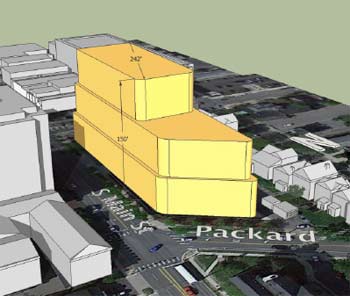Planning Group Continues Zoning Review
Continuing a discussion that began at their Oct. 8 working session, Ann Arbor planning commissioners gave feedback on a consultant’s report with recommendations to changes in downtown zoning. The item was on the commission’s Oct. 15, 2013 agenda. [.pdf of downtown zoning report]

Illustration showing potential development on Main Street between William and Packard, if recommendations for new zoning standards are adopted. The changes would include reduced height and a new diagonal requirement, compared to existing zoning.
The commission’s Oct. 15 meeting also included a public hearing on the recommendations. Ten people spoke.
Although commissioners spent about two hours on this agenda item, they ultimately voted to postpone action and will continue their discussion at a future meeting.
In general, the recommendations – prepared by consultants ENP & Associates – call for some sections of the downtown to be downzoned, to create better transitions between residential neighborhoods and property that’s zoned for denser development. The recommendations also call for mandatory approval from the city’s design review board for any projects that are seeking premiums.
The report had been revised following feedback on Oct. 8. [See Chronicle coverage: "Downtown Zoning Review Nears Final Phase."] The recommendations reviewed on Oct. 15 include: (1) rezone the parcel located at 336 E. Ann from D1 (downtown core) to D2 (downtown interface); (2) rezone the Municipal Center parcel from PL (public land) to D2; (3) reduce the maximum height in the East Huron 1 Character District (on the north side of Huron, between Division and State) to 120 feet and add a tower diagonal maximum of 130 feet; (4) rezone the D-zoned parcels on the block bounded by Huron, Division, Ann and Fifth Avenue (where city hall is located) from East Huron 2 Character District to East Huron 1 Character District; (5) change the maximum height in the Main Street Character District to 150 feet when within 20 feet of a residentially zoned area and add a tower diagonal requirement of 50% of the maximum parcel diagonal; (6) rezone the south half of the parcel at 425 S. Main (between William and Packard) from D1 to D2.
In addition, several recommendations relate to premiums: (1) require approval of the design review board for a project to be eligible for any premium; (2) revise the residential premium to be more specific about the types of units that will be eligible for premiums; (3) revise the affordable housing premium so that the provision of affordable housing is mandatory for receiving any premiums; (4) eliminate the affordable housing 900% FAR (floor area ratio) “super premium”; and (5) include other types of premiums in addition to those currently available.
This zoning evaluation began earlier this year, following a city council directive to the planning commission that was prompted in part by the controversial 413 E. Huron development. Planning consultant ENP & Associates was hired to gather public input and evaluate certain aspects of downtown zoning known as A2D2, which was adopted in 2009. ENP’s Erin Perdu has taken the lead on this project, and attended the commission’s Oct. 15 meeting to answer questions.
The public hearing was held prior to a discussion by the commission. After the public hearing was opened and four people had spoken, Sabra Briere challenged a statement that commission chair Kirk Westphal had made at the opening of the hearing. Westphal had stated that anyone speaking at the Oct. 15 public hearing could not speak again when the hearing is continued at a future meeting. After debating the issue, commissioners voted 5-3 to allow people to speak at the public hearing over multiple meetings. Supporting that approach were Briere, Jeremy Peters, Paras Parekh, Bonnie Bona and Eleanore Adenekan. Three commissioners – Westphal, Diane Giannola and Wendy Woods – were in favor of one speaking turn only.
The commission will eventually vote on a final set of recommendations to be forwarded to the city council for consideration.
This brief was filed from the second-floor council chambers at city hall, where the planning commission holds its meetings. A more detailed report will follow: [link]



